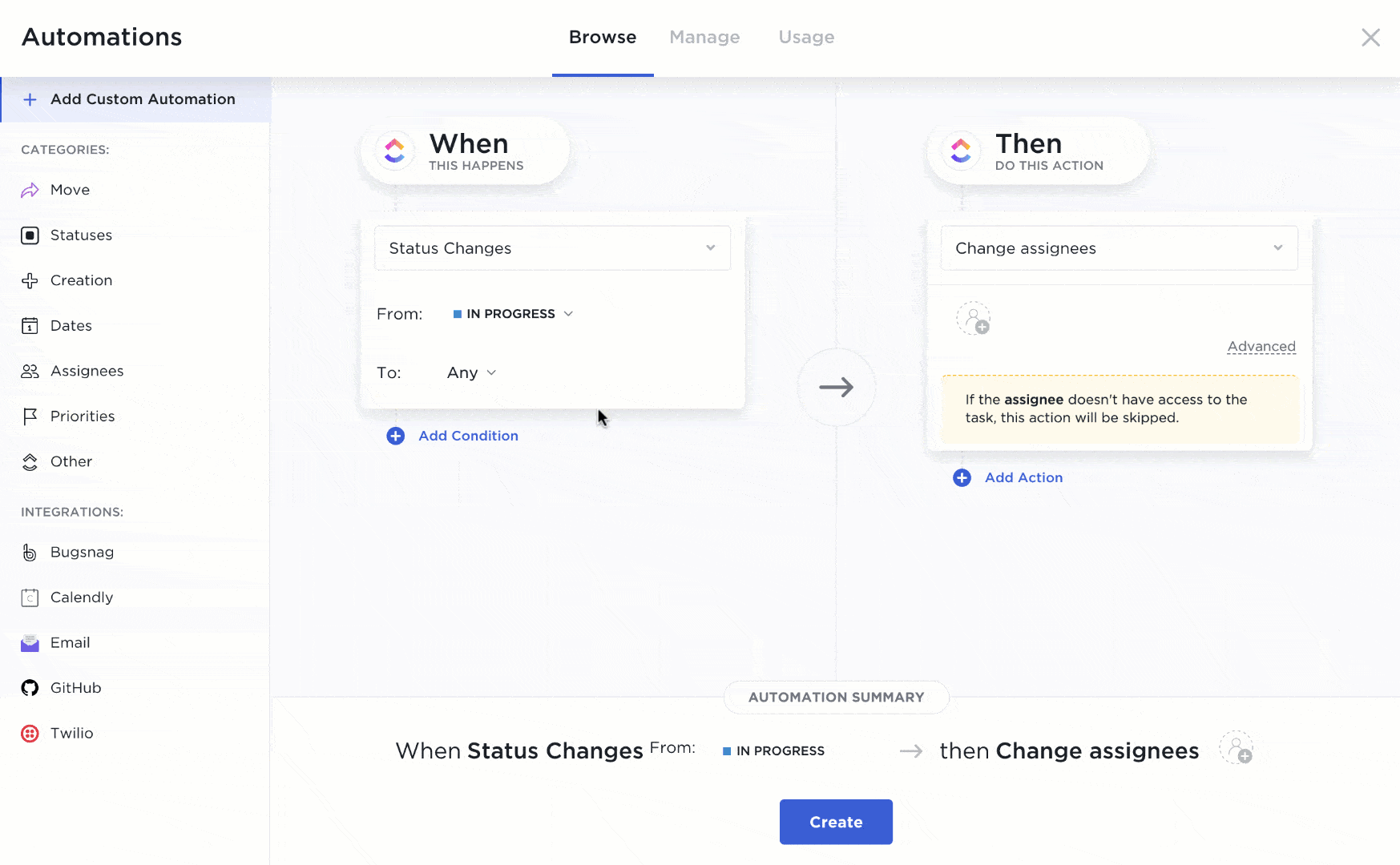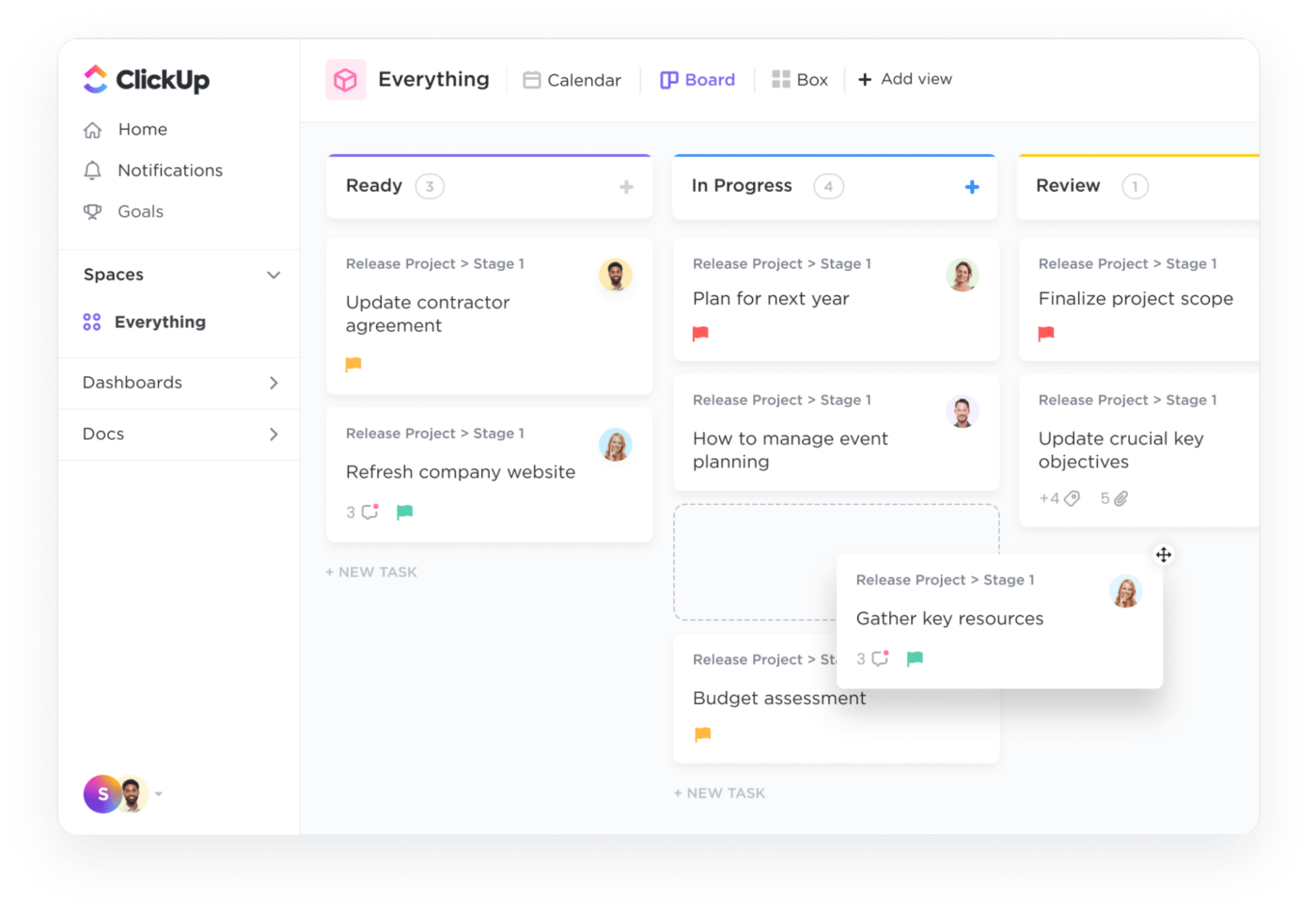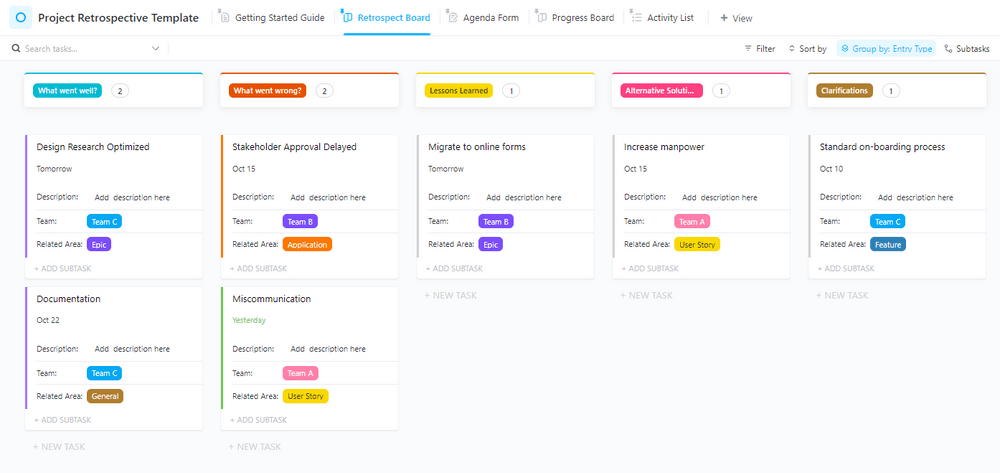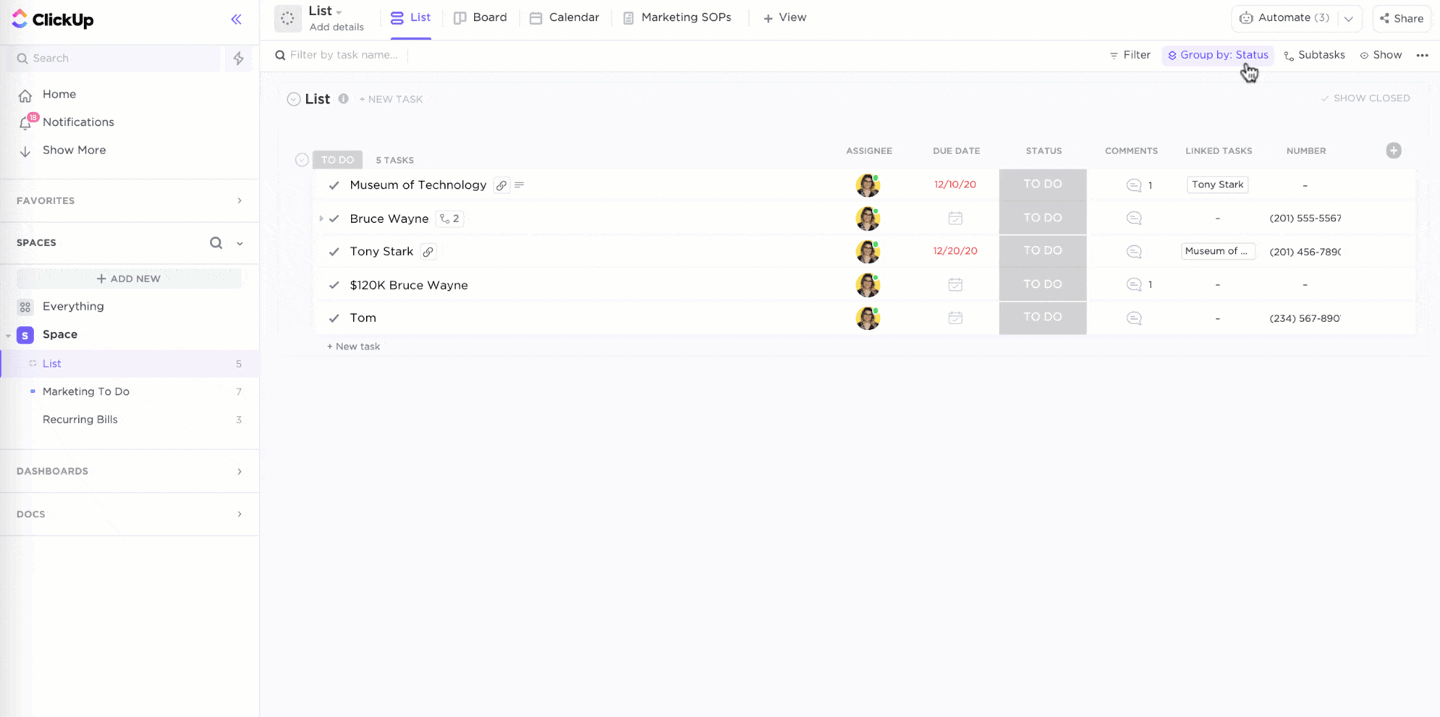تعمل الشركات على العمليات. من إجراءات التوظيف إلى تقييم المخاطر وتحديد الأهداف، تعمل العمليات وسير العمل في الخلفية لضمان تحقيق أهدافك.
التحقق من أن لديك عمليات فعالة في مكانها الصحيح يمكن أن يحدث فرقاً عندما يتعلق الأمر بالنجاح. وهذا يعني أنه لا يمكنك أن تترك العمليات تقوم بعملها فحسب، بل عليك أن تلعب دورًا نشطًا في صياغة وتطوير وتحسين سير العمل هذا باستمرار.
إحدى طرق القيام بذلك هي إجراء تحليل لسير العمل. ويتضمن ذلك مراجعة سير العمل والإجراءات بانتظام لمعرفة ما يعمل بشكل جيد وأين يمكن إجراء تحسينات.
سنتعمق هنا في تحليل سير العمل وسنعرض فوائد هذا النوع من المراجعة. بالإضافة إلى ذلك، سنعرض لك الأنواع المختلفة لتحليل سير العمل، وسنقدم لك نهجًا تفصيليًا لإجراء تحليل سير العمل خطوة بخطوة، وسنقدم أمثلة واقعية لتوجيه جهودك. ✨
ما هو تحليل سير العمل؟
تحليل سير العمل هو عملية مراجعة الإجراءات بهدف جعلها أكثر كفاءة. هذا النوع من التحليل جزء لا يتجزأ من إدارة الأعمال .
يتضمن فحص مهام سير العمل غير الفعالة ثم استخدام هذه الرؤى لإنشاء حلول أفضل. على سبيل المثال، يمكنك تحديد المهام اليدوية المتكررة التي يمكن أتمتتها أو إيجاد طريقة جديدة لتقسيم العمل بناءً على النطاق الترددي لفريقك.
وباختصار، فإن تحليل سير العمل هو وسيلة لك لفحص الاتجاهات في سير العمل لديك، واكتشاف نقاط الضعف في عمليتك، وتوليد نتائج للتحسين. 📝
بشكل عام، تتضمن عملية تحليل سير العمل ما يلي:
- توثيق سير العمل الحالي
- تحديد نقاط الضعف أو العوائق
- تحديد المهام المثالية للأتمتة
- وضع خطط عمل تتضمن رؤى التحليل
 ## 4 فوائد تنفيذ تحليل سير العمل ## 4 فوائد تنفيذ تحليل سير العمل
## 4 فوائد تنفيذ تحليل سير العمل ## 4 فوائد تنفيذ تحليل سير العمل
هناك العديد من الفوائد لتحليل سير العمل، بما في ذلك تحسين الكفاءة، وتوقعات أوضح، وامتثال أبسط للوائح. لا يقتصر دور تحليل سير العمل على تبسيط العمل الداخلي لعملياتك التجارية فحسب، بل إنه يخلق أيضًا بيئة عمل أفضل وتضعك في موقعٍ يسمح لك بأن تكون أكثر تنافسية على الساحة الكبيرة.
فيما يلي بعض الفوائد الرئيسية لتحليل سير العمل.
1. كفاءة أفضل عبر الفرق المختلفة
الهدف الرئيسي من هذا التحليل هو إعادة هندسة العمليات التجارية وجعلها أكثر كفاءة. من خلال تبسيط سير عملك ، يمكنك التركيز على الأهداف الكبيرة التي بين يديك، دون أن تتراكم الأمور.

استخدم وصفات الأتمتة المُنشأة مسبقًا في ClickUp أو قم بتخصيصها بناءً على احتياجاتك، حتى يتمكن فريقك من التركيز على ما هو أكثر أهمية
تعني مراجعة العمليات أيضًا الاستغناء عن المهام الزائدة عن الحاجة، وتعيين المهام المجمعة لأعضاء الفريق الصحيحين، و تحديد أولويات المهام التي لها تبعيات. باستخدام إدارة سير العمل تظهر الأداة أتمتة سير العمل الفرص التي يمكنك من خلالها توفير وقت أعضاء الفريق حتى يتمكنوا من تركيز جهودهم في مكان آخر. 👩💻
2. زيادة القدرة على التكيف لاكتشاف الاختناقات وتجنبها
التحليل السليم لسير العمل هو عملية مستمرة. وهذا يعني أنك لا تقوم بهذه العملية مرة واحدة فقط.
بدلاً من ذلك، يجب عليك تحديد موعد لتحليل سير العمل كل ثلاثة أشهر أو سنويًا لإعادة تقييم كيفية قيامك بالأمور. قم بتضمين ذلك كخطوة أخيرة في المشروع حتى تتمكن من البدء في وضع الأساس لمشاريع مستقبلية ناجحة استنادًا إلى ملاحظات المشروع الحالية.
من خلال المراجعة المستمرة لإجراءاتك، تكون أكثر قدرة على التكيف مع تغيرات السوق، ورضا العملاء وتفضيلاتهم، ومعدل دوران الموظفين. كما أنك تكون أكثر استعدادًا للتعامل مع المعوقات من خلال توثيق نقاط القوة والضعف التي واجهتها في الماضي والأفكار حول كيفية حلها.
3. موظفون أكثر سعادة يعني سير عمل أكثر كفاءة
تعمل إدارة وتحليل سير العمل على بناء بيئة عمل أفضل - خاصة عندما يتعلق الأمر بمشاركة الموظفين.
لا يتعين على الموظفين التعامل مع التكنولوجيا القديمة التي عفا عليها الزمن. شجِّع فريقك على تقديم اقتراحات عندما يتعلق الأمر بما يلي أدوات تحسين العمليات . نظرًا لأنهم هم الذين يعملون مع برامج إدارة سير العمل كل يوم، فهم في وضع جيد لإعطاء نظرة ثاقبة لما يحتاج إلى تحسين.

اطلع على أكثر من 15 طريقة عرض في ClickUp لتخصيص سير عملك حسب احتياجاتك
لا يؤدي ذلك إلى تحسين سير العمل فحسب، بل يؤدي أيضًا إلى تمكين موظفيك. فهم يشعرون بأنهم مسموعون ومحترمون ولديهم قدر أكبر من الاستقلالية والتحكم في إجراءات عملهم. 🤩
4. سهولة الامتثال والأطر التنظيمية
للأعمال التجارية العمليات في شركات الرعاية الصحية والوكالات الحكومية والشركات المالية أو المصرفية، فإن أدوات تحليل سير العمل تجعل الامتثال التنظيمي أكثر وضوحًا. فهي تمنحك نظرة ثاقبة وهيكلية بحيث يعرف الجميع ما هو مطلوب وتوفر تحديثات حول التقدم المحرز في الوقت الفعلي.
يتيح لك تحليل عملية الأعمال الحالية تطوير الهيكلية لتحسين الامتثال. إنشاء قواعد بيانات المعرفة كجزء من مهام سير العمل الخاصة بك لسرد جميع الأطر التنظيمية المطلوبة، وتعيين علامات للمهام لتتبع المساءلة، وإنشاء خطوات لتقارير التدقيق السريع.

يتيح ClickUp Docs التنسيق المنسق و أوامر الشرطة المائلة للعمل بكفاءة أكبر وتنظيم المستندات في محاور المعرفة داخل مؤسستك
الأنواع الرئيسية لتحليل سير العمل ## الأنواع الرئيسية لتحليل سير العمل
هناك ثلاثة أنواع مختلفة من تحليل سير العمل. يشترك كل منها في هدف تحسين عمليات سير العمل وتعزيز الكفاءة. 💪
فيما يلي أنواع تحليل سير العمل الثلاثة:
- خطي تحليل سير العمل: يركز هذا النوع من المراجعة على العمليات التي تعمل في خط مستقيم. هذه الطريقة هي الأفضل للمؤسسات التي لديها خطوات واضحة للمهام، وعمليات واضحة المعالم، ومسؤولية واضحة للموظفين
- متعدد الوظائف تحليل سير العمل : هذا النوع من التحليل مصمم لمراجعة العمليات عبر الأقسام أو في المؤسسات التي لا يوجد فيها تحديد واضح لخطوات المهام
- Hybrid تحليل سير العمل: يركز هذا النوع على التدقيق في سير العمل عبر الأقسام وداخل الأقسام. وهو مثالي لتقييم العمليات في المشاريع التي تشارك فيها إدارات مختلفة، ولكن هناك أيضًا عمليات داخل الإدارات تحتاج إلى تبسيطها
يمكن استخدام كل نوع من أنواع تحليل سير العمل لتحسين سير العمل في الأعمال. فكر في هيكلية شركتك أو مشروعك، واختر أفضل نوع من التحليل لتلبية تحسين سير العمل الاحتياجات.
كيفية إجراء تحليل سير العمل
هل أنت مستعد لدمج التحليل في نظام إدارة سير العمل الخاص بك؟ فيما يلي أربع خطوات لتحليل سير العمل لإجراء ورسم خريطة أفضل لعملية عمل فعالة. 🗺️
1. جمع البيانات لفهم ما يحتاج إلى تحسين
قبل أن تتمكن من البدء في التحسين، تحتاج إلى جمع رؤى حول ما يعمل وما يحتاج إلى تحسين. سيختلف نوع البيانات التي تحتاجها بناءً على نوع سير العمل الذي تقوم بتحسينه.
تأكد من تقييم كل من البيانات الكمية (مثل عدد المهام غير المكتملة) وكذلك البيانات النوعية (على سبيل المثال، كيف يشعر أعضاء الفريق بشأن الموارد المطلوبة للمهمة).

ارسم اتصالات بين أي شكل أو وسائط على السبورة البيضاء لإنشاء مخطط انسيابي في ClickUp
أفضل طريقة لجمع البيانات هي استعراض عمليتك الحالية باستخدام أداة مثل ClickUp Whiteboards إلى إنشاء مخططات انسيابية للعمليات الذي يتيح لك تتبع عملياتك وتحسينها باستخدام المخططات المرئية. انتقل خطوة بخطوة ودوّن ملاحظات حول من المسؤول عن أي من التسليمات وتسليط الضوء على العوائق المحتملة ⚠️
يجب عليك أيضًا إجراء مقابلات مع الموظفين للحصول على نظرة ثاقبة على المستوى الأساسي للمشروع. بالنسبة للمشاريع الأكثر تعقيدًا، استضف ورشة عمل حيث يمكن لكل موظف أن يطلعك على سير العمل الخاص به.
تتضمن بعض البيانات التي تريد البحث عنها ما يلي
- عدد المهام المسؤول عنها كل عضو من أعضاء الفريق
- الإطار الزمني العام لمهام المشروع
- مقدار الوقت المستغرق لإكمال مهمة ما
- عدد المرات التي تتكرر فيها المهمة
- عدد مرات إكمال المهام أو رفضها

اجمع كل أعمالك معًا في نظرة عامة عالية المستوى باستخدام لوحات المعلومات
استخدم لوحات معلومات ClickUp لعرض البيانات وتحليلها. يوفر نظرة عامة عالية المستوى لجميع المهام التي تشكل جزءًا من تحقيق أهداف الشركة. اعرض بسرعة ما هو قيد التنفيذ وما هو متأخر عن الجدول الزمني. بالإضافة إلى ذلك، يمكنك تحديد أوجه التكرار حتى تتمكن من تكييف مهام سير العمل لديك لتحقيق كفاءة أفضل من خلال نظرة عامة على تحليل سير العمل متعدد الوظائف.
2. تحليل البيانات للكشف عن مجالات التحسين
بمجرد أن تجمع الرؤى، يحين الوقت لتحليل البيانات. تذكر أن الهدف الرئيسي هو تحسين العمليات التي لا تعمل. في بعض الأحيان ستقوم بإجراء تغييرات كبيرة، وفي أحيان أخرى قد تكون هناك حاجة إلى تعديلات طفيفة.
يجعل ClickUp من السهل تحليل البيانات المخصصة بفضل إدارة سير العمل الميزات. يمكنك إنشاء مخطط سير العمل للحصول على خارطة طريق مرئية لجميع عملياتك الحالية. بهذه الطريقة، يمكنك الكشف عن الاختناقات وتوثيق الأنظمة الحالية التي تحتاج إلى تحسين.

اطلع على تقدم المهام وأين تقف الأمور مع طريقة عرض لوحة ClickUp
أداة أخرى رائعة أخرى هي عرض لوحة ClickUp Board View حيث يمكنك التمرير عبر كل مهمة والاطلاع بسرعة على كيفية انتقالها عبر مراحل المشروع.
انظر إلى البيانات التي جمعتها واسأل نفسك الأسئلة التالية:
- هل هذه المهمة أو العملية ضرورية؟
- ما الهدف من هذه المهمة؟
- هل تخدم غرضاً قيماً؟
- هل هذه المهمة تستغرق وقتاً طويلاً؟
- هل هناك مقاييس لقياس الأداء؟
- هل تقدم هذه العملية تجربة مستخدم سهلة؟
- هل يتطلب ذلك منحنى تعليمي حاد أو موارد تأهيلية كبيرة؟
- هل يمتلك الموظفون الموارد التي يحتاجونها لإكمال هذه الخطوة؟
- هل يمكن أتمتة هذه العملية اليدوية؟
من المفيد أيضًا فحص التغييرات التي سيكون لها أكبر الأثر، خاصةً إذا كان لديك وقت قصير أو موارد محدودة.

قم بتعيين أولويات المهام المرمزة بالألوان في ClickUp للسماح لفريقك بمعرفة ما يجب معالجته في أسرع وقت ممكن أولويات المهام في ClickUp تتيح لك الاختيار من بين أربع علامات لتحديد العناصر الأكثر أهمية. حدد أولويات التغييرات التي لها التأثير الأكبر والعمل الأقل المطلوب أولاً. يمكن أن تحدث هذه التغييرات فرقًا كبيرًا دون التأثير على ميزانيتك، ويمكنك العمل على معالجة التغييرات الأقل إلحاحًا بعد ذلك. 🙋🏻♂️
3. تنفيذ التغييرات من النتائج التي توصلت إليها
بمجرد مراجعة بياناتك، يجب أن تكون لديك رؤى حول التغييرات التي يجب إجراؤها على سير عملك.
ربما تكون قد حددت المهام التي ستستغرق وقتًا أقل إذا كانت مؤتمتة. ربما تكون قد حددت المجالات التي يمكن فيها تبسيط عمليات التسليم إلى أعضاء الفريق الآخرين. ربما تكون قد قررت أنك بحاجة إلى عمليات سير عمل جديدة أو ترغب في إنشاء ضوابط المشروع عند الضرورة للبقاء في حدود ميزانيتك.

من السهل إضافة قيم مالية إلى المهام لإبقاء ميزانيات المشاريع على المسار الصحيح
مهما كانت البيانات التي تخبرك بها، فكّر في كيفية إجراء تغييرات لتبسيط سير العمل. أدوات أتمتة العمليات مثل ميزة اللوحة البيضاء في ClickUp، تتيح لك تصور التغييرات في سير العمل. وبمجرد الانتهاء من وضع اللمسات الأخيرة على سير العمل، يمكنك إنشاء المهام في ثوانٍ مباشرةً من اللوحة البيضاء وإضافة السياق مع المستندات والأوصاف والملفات. 💪
تأكد من إعلام جميع أصحاب المصلحة بالتغييرات. من فريق إدارة المشروع إلى قسم الموارد البشرية، قم بإخطار أي شخص مشارك في العملية. قم بإنشاء إرشادات وتعليمات واضحة للتغييرات حتى يعرف الجميع ما هو متوقع للمضي قدمًا.
4. قم بمراجعة سير العمل بانتظام
لا ينتهي تحليل سير العمل بالتنفيذ. يجب عليك مراجعة عملياتك وتحليلها بانتظام لضمان كفاءة سير العمل والحفاظ على سير الأمور بسلاسة.
ضع جدولاً زمنياً لمراجعة أداء سير العمل. الاستفادة من أدوات إعداد التقارير و أدوات استرجاعية لمراقبة كيفية تقدم الأمور باستمرار.

يقيّم هذا القالب الاستعراضي للمشروع نجاح المشروع أو فشله بشكل عام مع تحديد التحسينات لتجنب الأخطاء المستقبلية
في الواقع، يمكنك استخدام قالب استرجاع مشروع ClickUp لجمع الملاحظات بسهولة، والعثور على نقاط القوة والضعف في سير العمل، وإجراء تغييرات لتحسين المشاريع المستقبلية. ✍️
قم بإجراء محادثات مع أعضاء فريقك للتأكد من أن الجميع على نفس الصفحة. ستحصل على ملاحظات قيّمة يمكنك تنفيذها ويمكنك تحسين سير عملك بناءً على اقتراحات الموظفين.
3 أمثلة على تحليل سير العمل
كل هذا يبدو رائعًا من الناحية النظرية، ولكن من الناحية العملية، يبدو أفضل! هل تريد بعض الأمثلة الواقعية لتحليل سير العمل؟ لقد قمنا بتغطيتك مع حالات الاستخدام المختلفة هذه. 👀
حالة الاستخدام 1: تبسيط نمو الشركة
عندما تصبح الشركات أكثر نجاحًا، فإنها تميل إلى النمو. فالعمليات والإجراءات التي استخدمتها مع فريق صغير مكون من خمسة إلى 10 أشخاص تبدأ فجأة في الانهيار عندما يرتفع عدد الموظفين إلى 50 موظفًا أو أكثر. وهذا يمنع العوائق التي تحول دون تحقيق الكفاءة، بل ويمكن أن تعيق نموك.
تحتاج إلى نظام سير عمل أكثر دقة أو مجزأ لمواكبة التغييرات. استخدم أتمتة سير العمل لإنشاء خارطة طريق جديدة للنجاح مع فريق أكبر وتحسين هذه العمليات.
بالإضافة إلى ذلك، مع وجود عدد أكبر من الأشخاص في الفريق، ستحصل على رؤى أكثر تنوعًا ومجموعة أكبر من الملاحظات، مما يؤدي إلى حلول مبتكرة. 🥳
حالة الاستخدام 2: تبسيط العمليات اليدوية
يتعامل العديد من مديري المشاريع وفرقهم مع المهام المتكررة يدويًا. وهذا يعني أحيانًا الرد على فواتير العميل عبر البريد الإلكتروني. وفي أحيان أخرى، قد يتضمن هذا العمل كتابة موجز مقالة المدونة نفسها مرارًا وتكرارًا من الصفر.
تستغرق هذه المهام وقتاً طويلاً، وعندما تبدأ في التوسع أو العمل على مشاريع أكبر، يمكن أن تتحول إلى مضيعة للوقت.

قم بأتمتة مهامك المتكررة ببضع نقرات فقط باستخدام أحد مئات قوالب أتمتة سير العمل في ClickUp
قم بأتمتة العمليات اليدوية كلما أمكنك ذلك. قد يعني ذلك استخدام أدوات مالية مثل QuickBooks للتعامل مع المدفوعات والفواتير. وقد يعني أيضًا استخدام تطبيقات إنشاء المحتوى وقوالب أخرى لتقليل الوقت المستغرق في إنشاء محتوى متكرر. ⌚️
حالة الاستخدام 3: التفاعل مع العملاء بشكل أكثر فعالية
التواصل مع العملاء أمر مهم للغاية. فأنت تريد تعليقات من المستخدمين حتى تتمكن من تقديم منتجات وخدمات أفضل.
بالنسبة للشركات الصغيرة، من السهل التواصل مع العملاء على المستوى الشخصي. يمكنك الرد على رسائل البريد الإلكتروني الخاصة بهم، وتقديم المشورة بشأن كيفية استخدام منتجاتك وخدماتك، واستكشاف المشكلات وحلها عند ظهورها.
مع وجود شركة أكبر والعديد من الموظفين بدوام كامل - أو عندما تتولى مشاريع أكبر - قد يكون من الصعب التعامل مع هذه المهام بنفسك. بالإضافة إلى ذلك، من المرجح أن تتركز جهودك بشكل أفضل على أهداف أكبر ومهام أكثر أهمية.

إدارة بيانات العميل والمهام الشخصية والاتصالات في ClickUp من أي جهاز
A أداة سير عمل إدارة علاقات العملاء هي طريقة أفضل لإدارة علاقات العملاء من خلال سير العمل الآلي. بعد تحليل عملياتك الحالية، يمكنك استخدام أداة CRM لأتمتة الاستجابات وإنشاء المهام لأعضاء الفريق المعنيين. 📚
قم بإجراء تحليل سير العمل وتبسيط عملياتك باستخدام ClickUp
دعم العمليات التجارية وقيادة فرق عمل أكثر كفاءة من خلال إضافة تحليل سير العمل إلى قائمة مهامك. مع هذا الدليل المفيد، لديك كل ما تحتاجه لجمع البيانات وتحليل النتائج وإنشاء عناصر العمل من مراجعة سير عملك. جرّب ClickUp اليوم للاستفادة من ميزات سير العمل بما في ذلك الرسوم البيانية ومخططات التدفق ومئات القوالب المصممة لجعل عملك أكثر منهجية. كل منها قابل للتخصيص بحيث يمكنك الاستفادة من الأداة لتلبية احتياجات عملك الخاصة. 🏙

